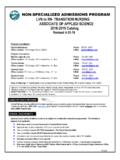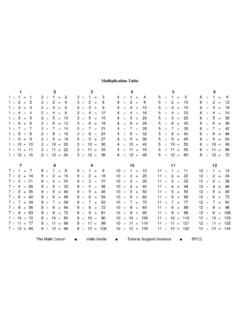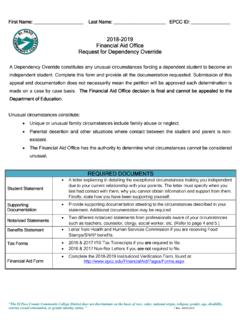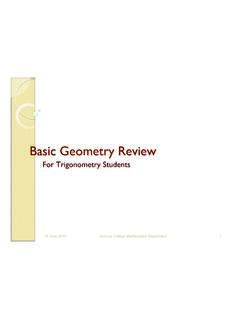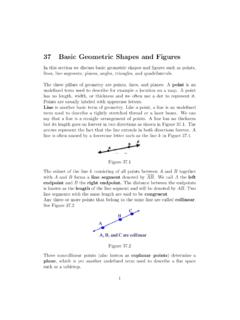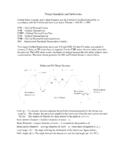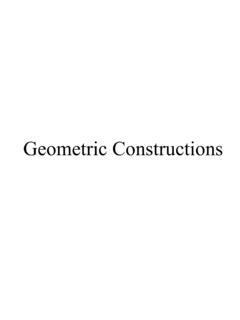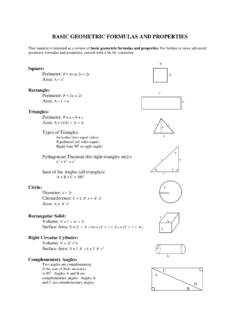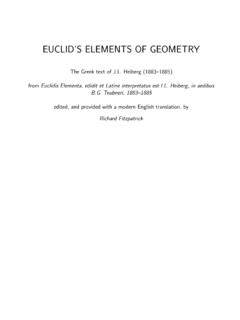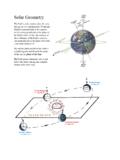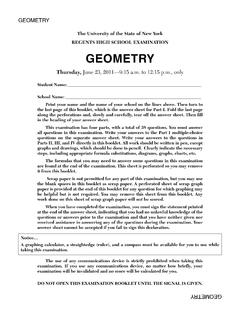Transcription of Geometry Definitions - El Paso Community College
1 Geometry Definitions Line: Is determined by two distinct end points and extends Ray: A part of a line that has only one endpoint. indefinitely in both directions. End Point: Is the point at which a ray starts. Perpendicular Lines: Intersecting lines that form right angles. Angles: Two rays joined at the same end point. Vertex: Is the point at which the two rays meet. Sides: What the sides of the ray are called. Parallel Lines: Lines that never intersect or cross each other. Right Angles: an angle that is exactly 90 degrees Straight Angle: One angle that equals 180 Basically, a straight angle is a straight line. Vertical Angles: Adjacent Angles: Vertical angles are opposite angles.
2 They will form two acute angles and Adjacent Angles are two angles that share a common two obtuse angles. side. They are also supplementary angles, which means, the measure of the sums of their angles must d and b are vertical obtuse angle. They have the same measure equal 180 degrees. a and c are vertical acute angles. They have the same measure Adjacent Angles a and d a and b b and c d and c Acute Angles: Complementary Angles: one angle between 0 and 90 degrees. Two angles whose measures add up to 90o. Obtuse Angles: Supplementary Angles: Two angles whose One angle between 90 and 180 degrees. measures add up to 180 . Transversal Alternate Interior Angles Two parallel lines intersected by a transversal form corresponding For any pair of parallel lines intersected by a third pairs of angles that are congruent.
3 Several types of angles are line, the transversal, alternate interior angles are formed: alternate interior, alternate exterior , corresponding and formed. Alternate interior angles have the same vertical angles. degree. o r p q Triangles: The sum of the interior angles of a triangle equal 180 Saved: Geometry Definitions Lines & Angles-1. 1. Similar Two polygons are similar if their corresponding sides are proportional. Similar Figures have the same shape, but not necessarily the same size. For Example: The triangles below are similar. Therefore, the measures of their corresponding angles are equal, and the corresponding sides are in proportion. Side AB corresponds to side DE.
4 Side AC corresponds to side DF. Side BC corresponds to side EF. AB AC 6 10.. DE DF n 5. 6 x 5 10n 3 n {the length of side DE is 3cm}. Alternate Exterior Angles For any pair of parallel lines 1 and 2, that are both intersected by a third line, such as line 3 in the diagram below, angle A and angle D are called alternate exterior angles. Alternate exterior angles have the same degree measurement. Angle B and angle C are also alternate exterior angles. n o m t Corresponding Angles Corresponding angles are two angles that are on the same side of the transversal. Both are acute angles or both are obtuse angles. They have the same measure. Corresponding Angles Study Tip: To help you remember this rule, think of corresponding angles as top-top and bottom-bottom Top Angles m q Bottom Angles o s Top Angles n r Bottom Angles p t Corresponding Interior Angles Angles on the same side of the transversal, and inside the parallel lines are supplementary angles, and therefore the sum of their measures equals 180 degrees.
5 O q are corresponding interior angles p r are corresponding interior angles Saved: Geometry Definitions Lines & Angles-1. 2.



